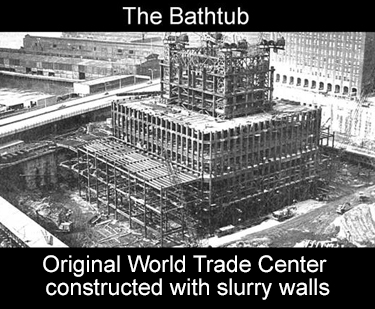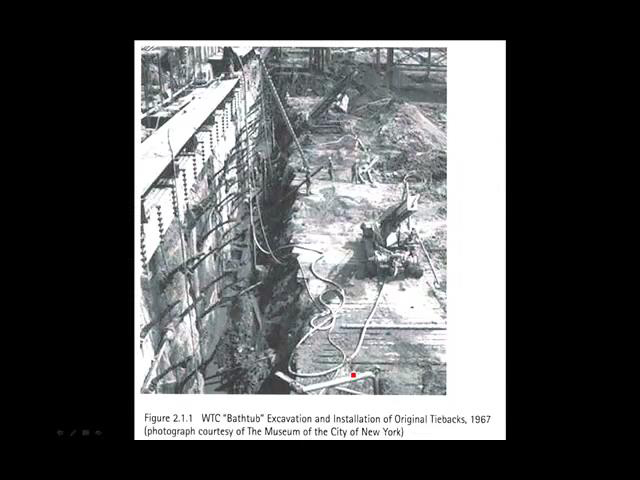Welcome to class number 4 in support of excavation part 2. We are going to discuss slurry walls. We need to define some terms here. What is always called a slurry wall is, in fact, a diaphragm wall, and I will explain that, but if you leave this lecture and continue to call it a slurry wall, you're in very good company. Everyone will know exactly what you mean, whereas if you called it a diaphragm wall, people may not know what you're talking about. So slurry wall is perfectly acceptable term.
 Perhaps the most famous slurry wall is the slurry wall constructed around the World Trade Center. This was done in the late 1960s. There were some real challenges to overcome. First of all, it's a very large site. It's a very deep excavation. The excavation takes place immediately adjacent to the Hudson River. It is almost entirely below the water table.
Perhaps the most famous slurry wall is the slurry wall constructed around the World Trade Center. This was done in the late 1960s. There were some real challenges to overcome. First of all, it's a very large site. It's a very deep excavation. The excavation takes place immediately adjacent to the Hudson River. It is almost entirely below the water table.
There are adjoining highways. There are adjoining buildings. The solution that was chosen was to construct slurry walls around the perimeter of the site. And it seems to have been an excellent choice, and a slurry walls have served very well.
Here's a better look at this wall, because the sun is shining on it. You can see this wall is the north wall of the excavation is immediately adjacent to a very tall building. That's not a conventional building. That building is actually filled with the switchgear for telephone service throughout Manhattan.
There are some other interesting features here. This is the old West Side Highway. I guess you have to be a certain age to remember the Westside Highway. It was an elevated highway. It ran around the lower part of Manhattan. Very effective way to get around. It collapsed through sheer neglect.
The structure was never maintained. It was never painted. It finally gave way entirely and a truck fell through the roadway. You would have thought that would lead to an immediate design of a new facility. Actually it took decades before the the old West Side Highway was completely rebuilt.
It's rebuilt now at grade. It has traffic signals and it's really not the same as having the old elevated highway. One portion of the highway still has not been rebuilt. It would have been rebuilt, but 9/11 came along and disrupted that. It is now under construction.
This is a really remarkable photo of the construction of one of the towers. This area is the elevator core. It has the elevators and also provides a structural core. This is the exterior wall of the Tower. It is also a structural element, a primary structural element, and the space between them is column free. This is an unusual framing system for a high-rise steel tower.
It came under some scrutiny after 9/11. There was a suggestion that this arrangement perhaps participated somehow in the collapse of the building. To the best of my knowledge, that was never proven to be the case. Everything about the design, as I recall, was proven to be excellent. It was innovative, it created huge floor plates which have made it very attractive space to rent.
This portion is an underground concourse. If you frequented this building, this was an area filled with the restaurants and shops and a tremendous amount of pedestrian traffic. It was a lively place, very prosperous, and you never had the feeling that you were deep down in a basement.
 Here's another slide of the old slurry wall, or the existing slurry wall. This is a drill which has been busy installing tiebacks. All of these projections that you see coming out of the wall are tiebacks or anchors. They are very long because they had to reach bedrock, which is quite some distance away. There are many of these tiebacks, and that was the means of restraining the slurry wall. The goal was to free the inside from any obstructions, any kind of bracing, any kind of struts.
Here's another slide of the old slurry wall, or the existing slurry wall. This is a drill which has been busy installing tiebacks. All of these projections that you see coming out of the wall are tiebacks or anchors. They are very long because they had to reach bedrock, which is quite some distance away. There are many of these tiebacks, and that was the means of restraining the slurry wall. The goal was to free the inside from any obstructions, any kind of bracing, any kind of struts.
Tiebacks were used exclusively to create that great, open space. The term bathtub was immediately adopted to describe this vast open space. Post 9/11, after all of the material was removed, the bathtub was apparent again and the term bathtub came right back into popular use. I think at this point, everybody knows about the bathtub around the World Trade Center site,
Many people know it is a slurry wall. Beyond that, slurry walls are not very well understood. I hope to able to clarify that for you in the next slides. I just want to acknowledge that these photos came from the Museum of the City of New York, and they're dated 1967.
This is a current photo. This was taken around January 2007. It shows the westerly slurry wall. This is the same wall that appeared in that photo from 40 years ago. There have been some changes. These are tiebacks, and they are new. When the original slurry wall was put in service, the tiebacks were destressed and therefore, when the site had to be re excavated, post 9/11, new tiebacks had to be installed.